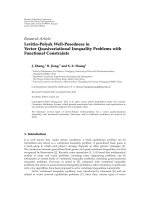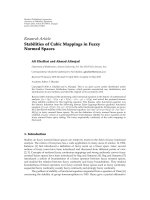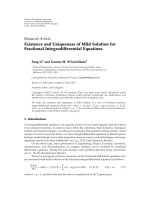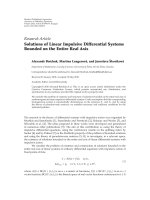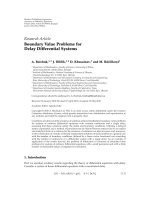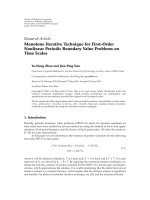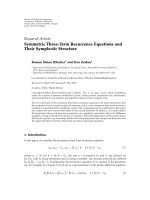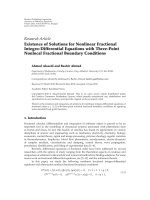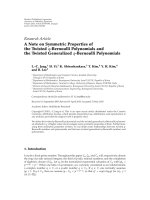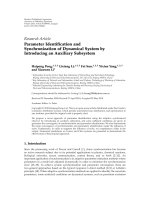Báo cáo sinh học: " Research Article One-Dimensional Compressible Viscous Micropolar Fluid Model: Stabilization of the Solution for the Cauchy Problem" pot
Bạn đang xem bản rút gọn của tài liệu. Xem và tải ngay bản đầy đủ của tài liệu tại đây (551.25 KB, 21 trang )
Hindawi Publishing Corporation
Boundary Value Problems
Volume 2010, Article ID 796065, 21 pages
doi:10.1155/2010/796065
Research Article
One-Dimensional Compressible Viscous
Micropolar Fluid Model: Stabilization of
the Solution for the Cauchy Problem
´
Nermina Mujakovic
Department of Mathematics, University of Rijeka, Omladinska 14, 51000 Rijeka, Croatia
Correspondence should be addressed to Nermina Mujakovi´ ,
c
Received 8 November 2009; Revised 24 May 2010; Accepted 1 June 2010
Academic Editor: Salim Messaoudi
Copyright q 2010 Nermina Mujakovi´ . This is an open access article distributed under the
c
Creative Commons Attribution License, which permits unrestricted use, distribution, and
reproduction in any medium, provided the original work is properly cited.
We consider the Cauchy problem for nonstationary 1D flow of a compressible viscous and
heat-conducting micropolar fluid, assuming that it is in the thermodynamical sense perfect and
polytropic. This problem has a unique generalized solution on R× 0, T for each T > 0. Supposing
that the initial functions are small perturbations of the constants we derive a priori estimates for
the solution independent of T , which we use in proving of the stabilization of the solution.
1. Introduction
In this paper we consider the Cauchy problem for nonstationary 1D flow of a compressible
viscous and heat-conducting micropolar fluid. It is assumed that the fluid is thermodynamically perfect and polytropic. The same model has been considered in 1, 2 , where
the global-in-time existence and uniqueness for the generalized solution of the problem on
R× 0, T , T > 0, are proved. Using the results from 1, 3 we can also easily conclude that the
mass density and temperature are strictly positive.
Stabilization of the solution of the Cauchy problem for the classical fluid where
microrotation is equal to zero has been considered in 4, 5 . In 4 was analyzed the Holder
ă
continuous solution. In 5 is considered the special case of our problem. We use here some
ideas of Kanel’ 4 and the results from 1, 5 as well.
Assuming that the initial functions are small perturbations of the constants, we first
derive a priori estimates for the solution independent of T . In the second part of the work we
analyze the behavior of the solution as T → ∞. In the last part we prove that the solution of
our problem converges uniformly on R to a stationary one.
2
Boundary Value Problems
The case of nonhomogeneous boundary conditions for velocity and microrotation
which is called in gas dynamics “problem on piston” is considered in 6 .
2. Statement of the Problem and the Main Result
Let ρ, v, ω, and θ denote, respectively, the mass density, velocity, microrotation velocity, and
temperature of the fluid in the Lagrangean description. The problem which we consider has
the formulation as follows 1 :
∂ρ
∂t
∂v
∂t
ρ
ρ
∂θ
∂t
−Kρ2 θ
∂v
∂x
∂ω
∂t
ρ2
ρ2
∂v
∂x
0,
2.1
−K
∂
ρθ ,
∂x
2.2
∂
∂ω
ρ
∂x
∂x
−ω ,
2.3
∂
∂v
ρ
∂x
∂x
A ρ
∂v
∂x
2
ρ2
∂ω
∂x
2
ω2
Dρ
∂θ
∂
ρ
∂x
∂x
2.4
in R × R , where K, A, and D are positive constants. Equations 2.1 – 2.4 are, respectively,
local forms of the conservation laws for the mass, momentum, momentum moment, and
energy. We take the following nonhomogeneous initial conditions:
ρ x, 0
ρ0 x ,
v x, 0
v0 x ,
ω x, 0
ω0 x ,
θ x, 0
2.5
θ0 x
for x ∈ R, where ρ0 , v0 , ω0 , and θ0 are given functions. We assume that there exist m, M ∈ R ,
such that
m ≤ ρ0 x ≤ M,
m ≤ θ0 x ≤ M,
x ∈ R.
2.6
In the previous papers 1, 2 we proved that for
ρ0 − 1, v0 , ω0 , θ0 − 1 ∈ H 1 R
2.7
the problem 2.1 – 2.5 has, for each T ∈ R , a unique generalized solution:
x, t −→ ρ, v, ω, θ x, t
x, t ∈ Π
R × 0, T ,
2.8
Boundary Value Problems
3
with the following properties:
ρ − 1 ∈ L∞ 0, T ; H 1 R
∩ H1 Π ,
2.9
v, ω, θ − 1 ∈ L∞ 0, T ; H 1 R
∩ H 1 Π ∩ L2 0, T ; H 2 R .
Using the results from 1, 3 we can easily conclude that
θ, ρ > 0 in Π.
2.10
We denote by Bk R , k ∈ N0 , the Banach space
Bk R
0, 0 ≤ n ≤ k ,
u ∈ Ck R : lim |Dn u x |
|x| → ∞
2.11
where Dn is nth derivative; the norm is defined by
u
sup sup|Dn u x | .
Bk R
2.12
x∈R
n≤k
From Sobolev’s embedding theorem 7, Chapter IV and the theory of vector-valued
distributions 8, pages 467–480 one can conclude that from 2.9 one has
ρ − 1 ∈ L∞ 0, T ; B0 R
v, ω, θ − 1 ∈ L2 0, T ; B1 R
∩C
∩C
0, T ; L2 R ,
2.13
∩ L∞ 0, T ; B0 R ,
0, T ; H 1 R
2.14
and hence
v, ω, θ − 1 ∈ C
0, T ; B0 R ,
ρ ∈ L∞ Π .
2.15
From 2.7 and 2.6 it is easy to see that there exist the constants E1 , E2 , E3 , M1 ∈ R , M1 > 1,
such that
1
2
R
2
v0 dx
1
2A
R
2
ω0 dx
K
R
1
2
1
2
R
R
1
1
− ln
− 1 dx
ρ0
ρ0
v02
1 2
ω
A 0
1 2
ρ dx
2 0
ρ0
R
θ02 dx
v0 ln
E2 ,
1
dx ≤ E3 ,
ρ0
sup θ0 x < M1 .
|x|<∞
θ0 − ln θ0 − 1 dx
E1 ,
2.16
R
2.17
2.18
2.19
4
Boundary Value Problems
As in 5 , we can find out the real numbers η and η, η < 0 < η, such that
0
η
eη − 1 − η dη
η
eη − 1 − η dη
E5 ,
2.20
0
where
E5
2
E1 E4
K
1/2
,
E4
2μE1 1
E3
,
E1
M1
μ
max
K
,1 .
2D
2.21
Using η and η we construct the quantities
exp η,
u
exp η.
u
2.22
The aim of this work is to prove the following theorem.
Theorem 2.1. Suppose that the initial functions satisfy 2.6 , 2.7 , and the following conditions:
E1
R
v02 dx <
E1 A
R
2
2E1 48E4 M1 E1
u
u
< min
D u
⎩ 12A u
8
2KM1 E4
9M1
3AE1
D
2
,
u
u
Du
24 u
u2
2
2
,
Du
12 u
ω02 dx <
2
E1 M1 u2 1
⎧
⎨
Du
24 u
2.23
2
,
2
E1 K 2 M1
D
2.24
u
u
3M1
2
E2
M1
,
2
s − 1 − ln s ds
1
,
⎫
s − 1 − ln s ds
0
1
2⎬
;
⎭
2.25
then, when t → ∞,
ρ x, t −→ 1,
v x, t −→ 0,
ω x, t −→ 0,
θ x, t −→ 1,
2.26
uniformly with respect to all x ∈ R.
Remark 2.2. Conditions 2.23 – 2.25 mean that the constants E1 , E2 , E3 , and M1 are sufficiently small. In other words the initial functions ρ0 , v0 , ω0 , and θ0 are small perturbations of
the constants.
Boundary Value Problems
5
In the proof of Theorem 2.1, we apply some ideas of 4 and obtain the similar results
as in 5 where a stabilisation of the generalized solution was proved for the classical model
where ω 0 .
3. A Priori Estimates for ρ, v, ω, and θ
Considering stabilization problem, one has to prove some a priori estimates for the solution
independent of the time variable T , which is the main difficulty. When we derive these
estimates we use some ideas from 4, 5 . First we construct the energy equation for the
solution of problem 2.1 – 2.4 under the conditions indicated above and we estimate the
function 1/ρ.
Lemma 3.1. For each t > 0 it holds that
1
2
1
2A
v2 dx
R
R
t
0
θ − ln θ − 1 dx
ω2 dx
ρ
θ
R
R
2
∂v
∂x
1
1
− ln − 1 dx
ρ
ρ
K
R
ρ
θ
2
∂ω
∂x
ω2
ρθ
ρ
D 2
θ
∂θ
∂x
3.1
2
dx dτ
E1 ,
where E1 is defined by 2.16 .
Proof. Multiplying 2.1 , 2.2 , 2.3 , and 2.4 , respectively, by Kρ−1 1 − ρ−1 , v, A−1 ρ−1 ω, and
ρ−1 1 − θ−1 , integrating by parts over R and over 0, t , and taking into account 2.13 and
2.14 , after addition of the obtained equations we easily get equality 3.1 independently of
t.
If we multiply 2.2 by ∂/∂x ln 1/ρ , integrate it over R and 0, t , and use some
equalities and inequalities which hold by 2.1 and 2.13 – 2.15 together with Young’s
inequality we get, as in 5 , the following formula:
1
4
ρ2
R
∂
∂x
≤
2
1
ρ
dx
K
2
v2 dx
R
1
2
R
K
2
t
0
R
ρ
θ
t
0
θρ3
R
∂θ
∂x
∂
∂x
2
1
ρ
2
dx dτ
t
dx dτ
ρ
0
R
∂v
∂x
2
dx dτ
R
v0 ln
1
dx
ρ0
3.2
1 2
ρ dx
2 0
ρ0
for each t > 0. Using 3.1 , 2.16 , 2.18 , and 2.21 we get easily
1
4
ρ2
R
∂
∂x
1
ρ
2
dx
K
2
t
0
θρ3
R
∂
∂x
1
ρ
2
dx dτ ≤ K1 θ t ,
3.3
6
Boundary Value Problems
where
θ t
sup
x,τ ∈R× 0,t
θ x, τ ,
2μE1 1
K1 θ t
E3
.
E1
θ t
3.4
As in 5 , we introduce the increasing function
η
ψ η
eξ − 1 − ξ dξ
3.5
0
that satisfies the following inequality:
1
ψ ln
ρ
≤
R
1
1
− 1 − ln
dx
ρ
ρ
1/2
ρ
R
2
∂
∂x
1
ρ
1/2
2
dx
≤ K2 θ t ,
3.6
where
K2 θ t
2E1
2μ
1
K
We can easily conclude that there exist the quantities η θ t
1
0
η θ t
1
eη − 1 − η dη
η1 θ t
1/2
E3
E1
θ t
3.7
.
< 0 and η1 θ t
eη − 1 − η dη
> 0, such that
K2 θ t .
3.8
0
Comparing 3.8 and 3.6 we obtain, as in 5, Lemma 3.2 , the following result.
Lemma 3.2. For each t > 0 there exist the strictly positive quantities u1
exp η1 θ t
exp η θ t
1
and u1
such that
u1 ≤ ρ−1 x, τ ≤ u1 ,
x, τ ∈ R × 0, t .
Now we find out some estimates for the derivatives of the functions v, ω, and θ.
3.9
Boundary Value Problems
7
Lemma 3.3. For each t > 0 it holds that
1
2
2
∂v
∂x
R
2
6u1/2
1
Du1
D
12
2
R
∂ω
∂x
ρ
2
−
K3 θ τ
dx
R
∂v
∂x
dx dτ
3.10
2
2
2
−
K4 θ τ
dx
R
∂ω
∂x
2
dx dτ
2
∂2 θ
∂x2
R
dx
2
∂v
∂x
t
2
∂θ
∂x
R
0
t
0
t
0
3u1
Du1
2
2
1 ∂ω
A ∂x
dx dτ ≤ K5 θ t ,
where
2
3.11
2
Du1
,
1/2
12u1 A1/2 E1
2
48K1 θ t θ t E1
E1 K 2 θ t
D
,
1/2
24u1 E1
K4 θ t
K5 θ t
2
Du1
K3 θ t
u1
u1
3.12
2
u1
u1
8
2Kθ t K1 θ t
9θ t
3.13
3θ t
2
3AE1
D
E1 θ t u2 1
1
u1
u1
u2
1
E2 .
Proof. Multiplying 2.2 , 2.3 , and 2.4 , respectively, by −∂2 v/∂x2 , −A−1 ρ−1 ∂2 ω/∂x2 , and
−ρ−1 ∂2 θ/∂x2 , integrating over R× 0, t , and using the following equality:
−
t
0
R
∂v ∂2 v
dx dτ
∂t ∂x2
1
2
∂v
∂x
R
2
dx|t
0
3.14
that is satisfied for the functions θ and ω as well, after addition of the obtained equalities we
find that
1
2
R
∂v
∂x
2
t
ρ
0
R
2
1 ∂ω
A ∂x
∂2 ω
∂x2
∂θ
∂x
2
2
dx|t
0
t
dx dτ
D
ρ
0
R
t
ρ
0
∂2 θ
∂x2
R
∂2 v
∂x2
2
dx dτ
2
dx dτ
8
Boundary Value Problems
t
−
0
R
t
−
K
ρ
0
R
∂ρ ∂ω ∂ ω
dx dτ
∂x ∂x ∂x2
t
∂v
∂x
ρ
0
R
t
−D
0
R
2
R
t
2
0
−
t
∂ρ ∂v ∂2 v
dx dτ
∂x ∂x ∂x2
K
R
ω∂ ω
dx dτ
ρ ∂x2
t
0
2
∂ω
∂x
ρ
R
θ
0
R
t
2
0
∂2 θ
dx dτ −
∂x2
t
∂θ ∂2 v
dx dτ
∂x ∂x2
K
ρθ
0
R
∂2 θ
dx dτ −
∂x2
∂ρ ∂2 v
dx dτ
∂x ∂x2
∂v ∂2 θ
dx dτ
∂x ∂x2
t
0
R
ω2 ∂2 θ
dx dτ
ρ ∂x2
∂ρ ∂θ ∂2 θ
dx dτ.
∂x ∂x ∂x2
3.15
Using 3.3 , 3.9 , the inequality
2
∂v
∂x
≤2
R
1/2
2
∂v
∂x
⎛
2
∂2 v
∂x2
⎝
R
⎞1/2
⎠
3.16
,
that holds for the functions ∂θ/∂x, ∂ω/∂x, v, and ω as well, and applying Young’s inequality
with a sufficiently small parameter on the right-hand side of 3.15 , we find, similarly as in
5 , the following estimates:
t
0
R
≤
∂ρ ∂v ∂2 v
dx dτ
∂x ∂x ∂x2
t
0
R
2u1/2
≤ 1
u1
2
∂ρ
∂x
1
ρ
t
0
R
1
ρ2
2
∂v
∂x
dx dτ
∂ρ
∂x
1
4
2
dx
R
t
0
R
∂v
∂x
2
∂2 v
∂x2
ρ
dx dτ
1/2
2
⎛
⎝
dx
∂2 v
∂x2
ρ
R
⎞1/2
2
dx⎠
dτ
3.17
t
1
4
≤
5
16
5
≤
16
ρ
0
R
t
R
R
∂2 v
∂x2
t
ρ
0
∂v
∂x2
∂2 v
∂x2
ρ
0
2
2
dx dτ
2
dx dτ
16K1 θ t
2
dx dτ
16K1 θ t
t
2 u1
u2
1
u1
u1
0
∂v
∂x
R
2
t
θ t
0
R
2
dx dτ
ρ
θ
∂v
∂x
2
dx dτ,
Boundary Value Problems
t
K
ρ
0
R
∂θ ∂2 v
dx dτ
∂x ∂x2
∂θ
∂x
ρ
0
R
2
t
t
≤ K2
ρ
θ2
2
≤
K 2 u1 θ t
u1
t
K
θ
0
R
≤K
0
t
2
θ2
ρ
R
≤K θ t
θρ
0
R
t
0
R
≤
3
8
R
2
dx dτ,
R
2
dx dτ
t
1
4
dx dτ
2
∂2 v
∂x2
ρ
0
2
R
∂ω
∂x2
R
0
∂2 ω
∂x2
t
ρ
0
1
4
dx dτ
∂ρ
∂x
2
∂2 v
∂x2
ρ
0
3.19
R
dx dτ,
t
0
2
R
∂ω
∂x
dx
R
2
∂2 ω
∂x2
ρ
dx dτ
1/2
2
⎛
⎝
dx
ρ
R
⎞1/2
2
∂2 ω
∂x2
dx⎠
dτ
3.20
2
∂2 ω
∂x2
R
2
∂ω
∂x
1
ρ2
R
ρ
0
ρ
dx dτ
⎛
2
⎜
2⎝
dx dτ
8K1 θ t u1/2
1
u1
2
dx dτ
2 8K1 θ t
⎞2
⎟
⎠
t
0
u1
u1
2
∂ω
∂x
R
t
θ t
0
R
ρ
θ
2
dx dτ
∂ω
∂x
2
dx dτ,
ω ∂2 ω
dx dτ
ρ ∂x2
t
0
≤
0
t
3
≤
8
R
0
3.18
∂2 v
∂x2
ρ
t
1
4
1
ρ
∂
∂x
3
2
t
t
1
4
0
dx dτ
t
1
4
dx dτ
dx dτ
R
∂ρ
∂x
1
ρ
2u1/2
≤ 1
u1
t
R
∂ρ ∂ω ∂2 ω
dx dτ
∂x ∂x ∂x2
≤
≤
0
2
∂2 v
∂x2
ρ
2
∂θ
∂x
2
∂ρ
∂x
t
2
0
R
t
1
4
dx dτ
∂ρ ∂2 v
dx dτ
∂x ∂x2
0
t
9
u2 θ
1
R
ω2
dx dτ
ρ3
t
t
0
R
1
4
t
∂2 ω
∂x2
ρ
0
ω2
dx dτ
ρθ
R
1
4
t
ρ
0
R
2
dx dτ
∂2 ω
∂x2
3.21
2
dx dτ,
10
Boundary Value Problems
t
K
ρθ
0
R
∂v ∂2 θ
dx dτ
∂x ∂x2
t
3K 2
≤
2D
0
3
t
3K 2 θ t
≤
2D
t
ρ
0
R
2
∂v
∂x
t
3
≤
2D
0
3u1/2
≤ 1
Du1
t
0
dx dτ
R
D
6
t
dx dτ
R
3.22
2
∂2 θ
∂x2
ρ
0
2
∂2 θ
∂x2
ρ
0
2
4
2
0
ρ
0
R
dx dτ,
R
dx dτ
ρ
3
2
dx
dτ
⎞1/2
2
∂2 v
∂x2
R
∂v
∂x
2
∂2 θ
∂x2
⎛
⎝
dx
dx⎠
dτ
t
1
16
∂2 v
∂x2
ρ
0
D
6
R
t
ρ
0
R
∂2 θ
∂x2
2
dx dτ
2
dx dτ
2
∂2 θ
∂x2
R
t
D
6
3/2
2
t
ρ
0
dx dτ
∂v
∂x
R
t
D
6
dx dτ
∂v
∂x
t
D
6
∂2 θ
dx dτ
∂x2
3u1/2
1
Du1
≤4
R
ρ
θ
∂v
ρ
∂x
R
0
2
∂v
θ ρ
∂x
R
2
dx dτ,
3.23
t
ρ
0
R
≤
2
∂ω
∂x
t
3
2D
∂ω
∂x
ρ
0
R
3u1/2
≤ 1
Du1
≤2
∂2 θ
dx dτ
∂x2
t
0
2
D
6
t
ρ
0
R
∂2 θ
∂x2
ρ
0
R
ρ
R
∂ω
∂x
R
∂2 θ
∂x2
⎛
⎝
dx
t
0
3/2
2
t
D
6
dx dτ
∂ω
∂x
R
3u1/2
1
Du1
4
3
2
dx
dτ
dx dτ
⎞1/2
2
∂2 ω
∂x2
1
8
2
dx⎠
t
ρ
0
R
D
6
dτ
∂2 ω
∂x2
t
ρ
0
R
∂2 θ
∂x2
2
dx dτ
2
dx dτ
2
dx dτ,
3.24
Boundary Value Problems
t
0
R
ω2 ∂2 θ
dx dτ
ρ ∂x2
t
3
≤
2D
≤
≤
11
0
R
6AE1 u3
1
D
ω4
dx dτ
ρ3
t
ω2 dx
0
6AE1 u3
1
D
t
0
R
1/2
R
1/2
2
∂ω
∂x
ρ
ω2
x dτ
ρθ
dx dτ
dx
t
u1 θ t
2
0
D
6
dτ
ρ
θ
R
∂ω
∂x
t
∂2 θ
∂x2
ρ
0
R
2
dx dτ
2
dx dτ
2
∂2 θ
∂x2
ρ
0
R
R
θ t
2u1
2
∂2 θ
∂x2
ρ
0
R
t
D
6
t
D
6
dx dτ,
3.25
t
D
0
R
∂ρ ∂θ ∂2 θ
dx dτ
∂x ∂x ∂x2
t
3D
≤
2
0
R
3Du1/2
1
≤
u1
t
⎝
0
ρ
dx dτ
ρ
0
R
⎞1/2
∂θ
∂x
dx⎠
R
2
∂2 θ
∂x2
dx dτ
1/2
2
1
ρ2
dx
R
2
∂ρ
∂x
dx dτ
dx dτ
⎛
⎜
≤⎝
t
D
6
2
∂2 θ
∂x2
R
2
2
∂2 θ
∂x2
R
ρ
0
∂θ
∂x
⎛
t
D
6
2
∂ρ
∂x
1
ρ
12DK1 θ t θ t u1
u1
⎞2
⎟ 3
⎠
D
t
0
R
ρ
θ2
2
∂θ
∂x
dx dτ
D
4
t
ρ
0
R
∂2 θ
∂x2
2
dx dτ.
3.26
Inserting 3.17 – 3.26 into 3.15 and using estimates 3.1 , 3.3 , and 2.17 we obtain
1
2
R
∂v
∂x
1
4
≤ K5 θ t
2
1 ∂ω
A ∂x
t
ρ
0
R
∂2 ω
∂x2
6u1/2
1
Du1
2
∂θ
∂x
2
t
0
R
1
8
dx
D
12
dx dτ
2
2
∂v
∂x
t
ρ
0
R
t
∂2 v
∂x2
ρ
0
R
∂2 θ
∂x2
dx
dτ
dx dτ
2
dx dτ
3
2
2
2
3u1/2
1
Du1
2
t
0
R
∂ω
∂x
3
2
dx
dτ,
3.27
12
Boundary Value Problems
where K5 θ t
is defined by 3.10 . We also use the following inequality:
∂v
∂x
R
2
∂2 v
− v 2 dx ≤ u1/2
1
R ∂x
dx
v2 dx
R
ρ
⎞1/2
dx⎠
3.28
⎞1/2
2
∂v
∂x2
ρ
⎝
2
∂2 v
∂x2
R
2
1/2 ⎝
⎛
R
⎛
≤ 2E1 u1
1/2
dx⎠
that is satisfied for the function ∂ω/∂x as well. Therefore we have
ρ
R
2
∂ω
∂x2
ρ
R
2
∂2 v
∂x2
∂v
∂x
−1
dx ≥ 2E1 u1
R
2
dx
R
,
2
∂ω
∂x
−1
dx ≥ 2AE1 u1
2
2
2
dx
3.29
.
Inserting 3.29 into 3.27 we obtain
1
2
R
∂v
∂x
2
2
1 ∂ω
A ∂x
2
3u1/2
1
Du1
6u1/2
1
Du1
2
t
0
2
∂θ
∂x
R
t
0
R
2
∂ω
∂x
2
∂v
∂x
D
dx
12
⎛
t
ρ
0
2
⎝
dx
2
2
dx
R
2
dxdτ
2
Du1
Du1
1/2
24u1 E1
∂ω
∂x
−
1/2
12u1 A1/2 E1
⎛
⎝
∂2 θ
∂x2
R
2
−
R
∂v
∂x
2
2
⎞
dx⎠dτ
⎞
dx⎠dτ ≤ K5 θ t ,
3.30
and 3.10 is satisfied.
In the continuation we use the above results and the conditions of Theorem 2.1.
Similarly as in 4, 5 , we derive the estimates for the solution ρ, v, ω, θ of problem 2.1 –
2.7 , defined by 2.8 – 2.10 in the domain Π R× 0, T , for arbitrary T > 0.
Taking into account assumption 2.19 and the fact that θ ∈ C Π see 2.15 we have
the following alternatives: either
sup θ x, t
x,t ∈Π
θ T ≤ M1 ,
3.31
or there exists t1 , 0 < t1 < T , such that
θ t < M1
for 0 ≤ t < t1 ,
θ t1
M1.
3.32
Boundary Value Problems
13
Now we assume that 3.32 is satisfied and we will show later that because of the choice
E1 , E2 , E3 , and M1 the conditions of Theorem 2.1 , the property 3.32 is impossible.
Because K2 θ t , defined by 3.7 , increases with increasing θ t , we can easily
conclude that
< K2 M1
K2 θ t
and K2 M1
for 0 ≤ t < t1 ,
3.33
E5 . Therefore, comparing 2.20 and 3.8 , we obtain
u < u1 θ t ,
u > u1 θ t ,
3.34
where u, u, and u1 θ t , u1 θ t are defined by 2.22 and Lemma 3.2. It is important to
point out that the quantities K3 θ t and K4 θ t , defined by 3.11 - 3.12 , decrease with
M1 they become
increasing θ t and for θ t1
2
Du
K3 M1
,
1/2
24uE1
K4 M1
2
Du
1/2
12uA1/2 E1
.
3.35
Now, using these facts we will obtain the estimates for R ∂ω/∂x 2 dx and
∂v/∂x 2 dx on 0, t1 . Taking into account the assumptions 2.23 and 2.24 of Theorem 2.1
R
and the following inclusion see 2.14 :
∂v ∂ω
,
∈C
∂x ∂x
0, T ; L2 R ,
3.36
we have again the following two alternatives: either
R
∂v
∂x
2
x, t dx ≤ K3 M1 ,
R
∂ω
∂x
2
x, t dx ≤ K4 M1
for t ∈ 0, t1 ,
3.37
or there exists t2 , 0 < t2 < t1 , such that ∂ω/∂x and ∂v/∂x or conversely have the following
properties:
R
R
R
∂ω
∂x
2
x, t dx < K4 M1
3.38
for t2 < t1 ,
3.39
for 0 ≤ t ≤ t2 .
3.40
2
∂ω
∂x
∂v
∂x
for 0 ≤ t < t2 ,
x, t2 dx
2
K4 M1
x, t dx ≤ K3 M1
14
Boundary Value Problems
We assume that 3.38 – 3.40 are satisfied. Then we have
K4 M1 < K4 θ t ,
θ t < M1 ,
for t ∈ 0, t2 . Using 3.41 from 3.10 , for t
R
∂ω
∂x
2
K3 M1 < K3 θ t
3.41
t2 , we obtain
x, t dx ≤ 2AK5 θ t2
,
0 ≤ t ≤ t2 .
3.42
Since K5 θ t , defined by 3.13 , increases with the increase of θ t , it holds that
K5 θ t
≤ K5 M1 ,
t ∈ 0, t2 .
3.43
t ∈ 0, t2
3.44
Using condition 2.25 we get
2AK5 θ t
< K4 M1 ,
and conclude that
∂ω
∂x
R
2
x, t2 dx < K4 M1 .
3.45
This inequality contradicts 3.39 . Consequently, the only case possible is when
t2
t1 ,
3.46
and then for ∂ω/∂x 3.37 is satisfied.
If in 3.38 – 3.40 the functions ∂ω/∂x and ∂v/∂x exchange positions, using
assumption 2.25 , in the same way as above we obtain that the function ∂v/∂x satisfies
the inequality
R
2
∂v
∂x
x, t dx ≤ K3 M1 ,
t ∈ 0, t1 .
3.47
With the help of 3.37 from 3.10 we can easily conclude that
R
∂θ
∂x
2
x, t dx < 2K5 M1
for 0 < t ≤ t1 .
3.48
Now, as in 5 , we introduce the function Ψ by
Ψ θ x, t
θ x,t
1
s − 1 − ln s ds.
3.49
Boundary Value Problems
15
Taking into account that from 2.14 follows that θ x, t → 1 as |x| → ∞, we have
Ψ θ x, t
−→ 0 as |x| −→ ∞.
3.50
Consequently,
ψ θ x, t
≤ ψ θ x, t
θ x,t
d
ψ s ds
ds
1
x
θ x, t − 1 − ln θ x, t
−∞
≤
3.51
∂θ x, t
dx
∂x
θ x, t − 1 − ln θ x, t dx
1/2
R
∂θ
∂x
R
1/2
2
.
x, t dx
Using 3.32 , 3.48 , and 3.1 from 3.51 we get
max
0≤θ x,t ≤M1
ψ θ t1
ψ θ x, t
ψ M1 ≤ 2K5 M1 E1
1/2
,
3.52
or
M1
s − 1 − ln s ds − 2K5 M1 E1
1/2
≤ 0.
3.53
1
Since this inequality contradicts 2.25 , it remains to assume that t1
following lemma.
T . Hence we have the
Lemma 3.4. For each T > 0 it holds that
θ x, t ≤ M1 ,
2
R
∂ω
∂x
2
R
∂v
∂x
2
R
∂θ
∂x
x, t ∈ Π,
3.54
x, t dx ≤ K4 M1 ,
0 ≤ t ≤ T,
3.55
x, t dx ≤ K3 M1 ,
0 ≤ t ≤ T,
3.56
x, t dx ≤ 2K5 M1 ,
0 ≤ t ≤ T.
Proof. These conclusions follow from 3.32 , 3.37 , and 3.48 directly.
3.57
16
Boundary Value Problems
Lemma 3.5. It holds that
0
1
≤ u,
ρ x, t
x, t ∈ Π,
1/4
sup |ω x, t | ≤ 8AE1 K4 M1
x,t ∈Π
1/4
sup |v x, t | ≤ 8E1 K3 M1
x,t ∈Π
θ x, t ≥ h > 0,
3.58
,
3.59
,
3.60
x, t ∈ Π,
3.61
where u and u are defined by 2.20 – 2.22 and a constant h depends only on the data of problem
2.1 – 2.5 .
Proof. Because the quantity u1 θ t in Lemma 3.2 decreases with increasing θ t while
u1 θ t increases, it follows, in the same way as in 5 , from 3.9 and 3.54 that 3.58 is
satisfied. Using the inequalities
v2
x
2
−∞
v
∂v
dx ≤ 2
∂x
v2 dx
1/2
R
∂v
∂x
R
1/2
2
dx
,
3.62
ω2
x
2
−∞
ω
∂ω
dx ≤ 2
∂x
ω2 dx
1/2
R
∂ω
∂x
R
1/2
2
dx
and estimations 3.1 , 3.55 , and 3.56 we get immediately 3.59 and 3.60 . From 3.50 ,
3.53 , 3.56 , and 3.1 we have, as in 5 , for θ x, t ≤ 1 that
1
θ x,t
s − 1 − ln s ds ≤ 2K5 M1 E1
1/2
1
<
s − 1 − ln s ds
3.63
0
holds because of 2.25 . Hence we conclude that there exists the constant h > 0 such that
θ x, t ≥ h.
Boundary Value Problems
17
Remark 3.6. Using the properties of the functions u1
exp η θ t and u1
exp η1 θ t
1
defined in Lemma 3.2, from 3.55 - 3.56 and 3.59 - 3.60 we get the following estimates:
2
∂ω
∂x
R
R
2
∂v
∂x
dx ≤
1/2
24E1
sup |v x, t | ≤
1
3.64
exp −
1
2λ t
,
exp −
D2
72
x,t ∈Π
exp{−2λ t },
1/4
2
D
18
−η θ t
2
D
x,t ∈Π
η1 θ t
exp{−2λ t },
1/2
12A1/2 E1
sup |ω x, t | ≤
where λ t
2
D
dx ≤
1
2λ t
,
1/4
> 0.
Lemma 3.7. For each T > 0 it holds that
2
R
∂v
∂x
2
R
∂θ
∂x
2
R
∂ω
∂x
T
0
T
0
T
0
T
0
R
T
0
∂ρ
∂x
R
T
0
0
0
3.66
dx dτ ≤ K8 ,
3.67
3.68
2
dx dτ ≤ K10 ,
dx ≤ K11 ,
R
R
∂2 v
∂x2
R
∂2 ω
∂x2
T
dx dτ ≤ K7 ,
3.69
2
∂2 θ
∂x2
T
3.65
ω2
dx dτ ≤ K9 ,
ρθ
∂ρ
∂x
R
dx dτ ≤ K6 ,
t ∈ 0, T ,
3.70
2
dx dτ ≤ K12 ,
3.71
dx dτ ≤ K13 ,
3.72
2
2
dx dτ ≤ K14 ,
where the constants K6 , K7 , . . . , K14 ∈ R are independent of T .
3.73
18
Boundary Value Problems
Proof. Taking into account 3.58 , 3.61 , and 3.54 from 3.1 , 3.3 , 3.10 , and 3.27 we get
all above estimates.
4. Proof of Theorem 2.1
In the following we use the results of Section 3. The conclusions of Theorem 2.1 are immediate
consequences of the following lemmas.
Lemma 4.1. It holds that
2
∂v
∂x
R
2
∂ω
∂x
x, t dx −→ 0,
R
2
∂θ
∂x
x, t dx −→ 0,
R
x, t dx −→ 0,
4.1
when t → ∞.
Proof. Let ε > 0 be arbitrary. With the help of 3.65 – 3.69 we conclude that there exists t0 > 0
such that
t
t0
2
∂v
∂x
R
t
t0
2
∂θ
∂x
dx dτ < ε,
R
t
t0
2
∂ω
∂x
dx dτ < ε,
R
dx dτ < ε,
4.2
t
t0
t
2
R
ω
dx dτ < ε,
ρθ
t0
R
2
∂ρ
∂x
dx dτ < ε,
for t > t0 , and
∂v
∂x
R
2
x, t0 dx < ε,
R
2
∂θ
∂x
2
∂ω
∂x
x, t0 dx < ε,
R
x, t0 dx < ε.
Similarly to 3.10 , we have
1
2
R
∂v
∂x
2
1 ∂ω
A ∂x
2
6u1/2
Du
3u
2
Du
2
t
t0
2
R
t
t0
R
2
∂θ
∂x
dx
∂ω
∂x
t
ρ
t0
R
∂2 θ
∂x2
2
2
∂v
∂x
D
12
K3 θ τ
dx
−
R
2
2
dx
K4 θ τ
−
R
2
dx dτ
∂v
∂x
∂ω
∂x
2
dx dτ
2
dx dτ
4.3
Boundary Value Problems
≤
1
2
2
∂v
∂x
R
19
2
16K1 θ t
⎛
⎜
2⎝
t
u
u2
t0
2
8K1 θ t u1/2
u
t
3K 2
2D
t0
2
1 ∂ω
A ∂x
t
⎟
⎠
R
2
∂v
∂x
R
t0
t0
dx dτ
∂ω
∂x
3AE1 u
D
t
t0
∂ω
∂x
R
2
dx dτ
2
R
R
θ2
ρ
dx dτ
2
∂ρ
∂x
⎜
⎝
t
u2 θ t
dx dτ
t0
3AE1 θ t u3
Du
⎛
3
t
K2
dx dτ
2
∂θ
∂x
ρ
dx dτ
⎞2
t0
θ2 ρ
t
K2
x, t0 dx
2
∂v
∂x
R
2
∂θ
∂x
t
t0
R
R
ω2
dx dτ
ρθ
ω2
dx dτ
ρθ
12DK1 θ t u1/2
u
⎞2
⎟
⎠
t
t0
2
∂θ
∂x
R
dx dτ.
4.4
Taking into account 3.54 , 3.58 , 3.61 , and 4.2 – 4.3 from 4.4 we obtain
∂v
∂x
R
2
1 ∂v
A ∂x
2
∂θ
∂x
2
dx ≤ K15 ε
for t > t0 ,
4.5
where K15 depends only on the data of our problem and does not depend on t0 . Hence
relations 4.1 hold.
Lemma 4.2. It holds that
v x, t −→ 0,
ω x, t −→ 0,
θ x, t −→ 1
4.6
when t → ∞, uniformly with respect to all x, x ∈ R.
Proof. We have see 3.51 and 3.62
v2 x, t ≤ 2
1/2
R
v2 x, t dx
R
ω2 x, t ≤ 2
ω2 x, t dx
R
ψ θ x, t
≤
∂v
∂x
R
∂ω
∂x
1/2
θ x, t − 1 − ln θ x, t dx
R
1/2
2
,
x, t dx
1/2
2
1/2
R
∂θ
∂x
4.7
,
x, t dx
1/2
2
dx
.
20
Boundary Value Problems
Taking into account 3.1 from 4.7 we get
∂v
∂x
1/2
v x, t ≤ 2 2E1
2
R
ω2 x, t ≤ 2 2AE1
1/2
R
1/2
≤ E1
ψ θ x, t
R
1/2
2
∂ω
∂x
,
x, t dx
1/2
2
1/2
2
∂θ
∂x
4.8
,
x, t dx
dx
.
Using 4.1 and property 3.50 of the function ψ we can easily obtain that 4.6 holds.
Now, as in 5 , we analyze the behavior of the function ρ as t → ∞. From 3.69 and
3.72 we conclude that for ε > 0 there exists t0 > 0 such that
t
t0
R
∂ρ
∂x
2
t
dx dτ < ε,
t0
2
∂2 v
∂x2
R
dx dτ < ε,
R
∂ρ
∂x
2
x, t0 dx < ε
4.9
for t > t0 . Deriving 2.1 with respect to x, multiplying by ∂/∂x 1/ρ , and integrating over
R and t0 , t , after using 3.58 and Young’s inequality, we obtain
u4
2
R
2
∂ρ
∂x
dx ≤ u2
t
t0
u4
2
R
R
∂ρ
∂x
2
∂ρ
∂x
2
2
dx dτ
u2
t
t0
R
∂2 v
∂x2
dx dτ
4.10
x, t0 dx.
With the help of 4.9 we get easily the following result.
Lemma 4.3. It holds that
R
∂ρ
∂x
2
x, t dx −→ 0
4.11
when t → ∞.
Similarly as for the function ψ θ , we have
ψ
1/ρ
1
ρ
s − 1 − ln s ds
1
≤
R
1
1
− 1 − ln
dx
ρ
ρ
1/2
R
1
ρ2
∂ρ
∂x
4.12
1/2
2
dx
.
Boundary Value Problems
21
Taking into account 3.1 from 4.12 one has
ψ
1
ρ
≤ K −1 E1
1/2
u
R
∂ρ
∂x
1/2
2
dx
.
4.13
Using 4.11 we obtain the following conclusion.
Lemma 4.4. It holds that
ρ x, t −→ 1
4.14
when t → ∞, uniformly with respect to x ∈ R.
References
1 N. Mujakovi´ , “One-dimensional flow of a compressible viscous micropolar fluid: the Cauchy
c
problem,” Mathematical Communications, vol. 10, no. 1, pp. 1–14, 2005.
2 N. Mujakovi´ , “Uniqueness of a solution of the Cauchy problem for one-dimensional compressible
c
viscous micropolar fluid model,” Applied Mathematics E-Notes, vol. 6, pp. 113–118, 2006.
3 S. N. Antontsev, A. V. Kazhikhov, and V. N. Monakhov, Boundary Value Problems in Mechanics
of Nonhomogeneous Fluids, vol. 22 of Studies in Mathematics and Its Applications, North-Holland,
Amsterdam, The Netherlands, 1990.
4 Ja. I. Kanel’, “The Cauchy problem for equations of gas dynamics with viscosity,” Sibirski˘
ı
Matematicheski˘ Zhurnal, vol. 20, no. 2, pp. 293–306, 1979 Russian .
ı
5 N. Mujakovi´ and I. Draˇ i´ , “The Cauchy problem for one-dimensional flow of a compressible viscous
c
zc
fluid: stabilization of the solution,” Glasnik Matematiˇ ki. In press.
c
6 N. Mujakovi´ , “Nonhomogeneous boundary value problem for one-dimensional compressible viscous
c
micropolar fluid model: regularity of the solution,” Boundary Value Problems, vol. 2008, Article ID
189748, 15 pages, 2008.
7 R. Dautray and J.-L. Lions, Mathematical Analysis and Numerical Methods for Science and Technology. Vol.
2, Springer, Berlin, Germany, 1988.
8 R. Dautray and J.-L. Lions, Mathematical Analysis and Numerical Methods for Science and Technology. Vol.
5, Springer, Berlin, Germany, 1992.
